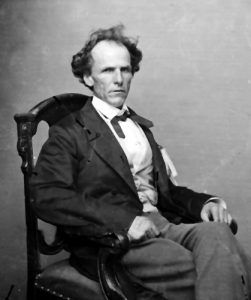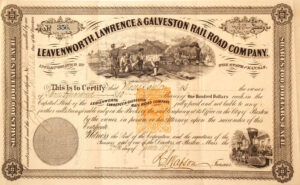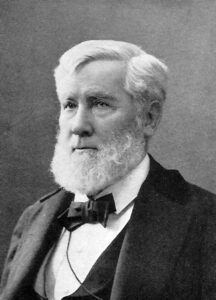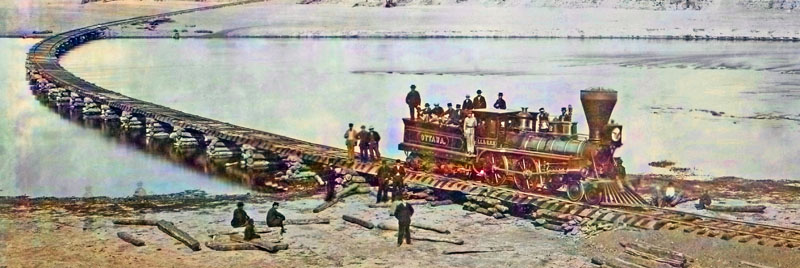
Leavenworth, Lawrence, and Galveston Railroad Bridge across the Kansas River at Lawrence, Kansas by Alexander Gardner, 1867.
In the winter of 1858, leading citizens of Leavenworth, Kansas, met and debated the possibilities of creating a railroad. A charter obtained on February 12 outlined a railroad down through Lawrence, Kansas, to the Neosho River. Once in the valley, it would run northwest to Fort Riley, Kansas, and southeast to Fort Gibson, Oklahoma, at the head of navigation on the Arkansas River. It was hoped that this railroad would help establish economic bonds with the South and link the cotton fields to the transcontinental railroad, which would then be projected across Kansas. The name of this ambitious project was the Leavenworth, Lawrence, & Fort Gibson Railroad. Many cities in Kansas liked the idea.
Just south of Lawrence, Prairie City became the corporate headquarters in August 1858. However, Prairie City lacked a political and economic base, and the headquarters were moved to Lawrence a year later. The developing Civil War delayed further progress.
Ongoing efforts to acquire part of the Osage Indian lands in southeastern Kansas finally bore fruit. In the fall of 1865, an agreement was established with the Indians, and the resulting treaty was sent to Congress for approval. During the legislative procrastination, settlers moved onto the Indian land and responded with violence when the railroad tried to remove them. The Osage Lands problem was further complicated in 1868 when the railroad negotiated a new treaty with the Indians. Congress settled into gridlock over whether an Indian nation could make a treaty with a corporation instead of a sovereign government. Controversy in government and squatter violence snarled the railroad’s claim to the Osage lands for years.
During the final years of the Civil War, the Leavenworth, Lawrence, & Fort Gibson Railroad had come under the control of Kansas Senator James Lane in 1865. Two boards of directors were elected at the same time. Lane was president of one set of officers while the old president sat on the other board. Control of the company was in doubt until another election placed Lane firmly in place. Lane intended to make Lawrence into an important city by building railroads in all directions. Through his efforts, the Union Pacific Railroad, Eastern Division (Kansas Pacific), was induced to pass through Lawrence instead of passing a few miles to the north. It also made Lawrence the junction of the Union Pacific, Eastern Division Leavenworth branch. Since operating rights could be obtained over the Leavenworth-Lawrence line, the Leavenworth, Lawrence, & Fort Gibson Railroad would not need to construct its line between those places. Senator Lane also obtained a Federal land grant for the Leavenworth, Lawrence, & Fort Gibson Railroad, but it was not as good a grant as he had planned.
Less than four months after Senator Lane assumed the presidency of the Leavenworth, Lawrence, & Galveston Railroad, Douglas County voted on September 12, 1865, $250,000 in bonds for a subscription to the stock of the line to be made upon its completion in that county.
Within the week that Douglas County voted on the railroad bonds, Senator Lane presented to the directors of the Galveston Road a resolution providing:
“That the executive committee be instructed to ascertain the cost of a double track railroad bridge across the Kansas River, including in connection therewith It double passenger track; and said the committee is further authorized to receive special city, county, and individual subscriptions of stock, payable as said work progresses, for the construction of the same. And when said committee shall obtain a sufficient amount of said stock, they are hereby empowered to contract for building said bridge, to be completed at as early a day as practicable…”
A bill Lane introduced to Congress granted ten sections of land for every mile constructed of a railroad South of Lawrence. The bill also provided for a branch of that railroad to the western boundary of Kansas. However, Senator Samuel Pomeroy, interested in the Atchison, Topeka & Santa Fe Railroad, amended the bill. As altered, the Leavenworth-Lawrence-South railroad obtained a grant only for the southward line.
After Senator Lane started on a speaking tour of the South in the interests of the Galveston road with appearances planned at Memphis, Vicksburg, and New Orleans, the railroad advertised for bids “for putting in the foundations and building the abutments and piers for the railroad bridge of this company across the river at Lawrence,” with January 1, 1866, the final day for filing proposals. The Kansas Daily Tribune said, “We are informed upon reliable authority… that it is the confident expectation of the company to have their bridge across the river at this point completed by spring.”
But ample credit and cash for railroad building were not forthcoming from promised county stock subscriptions to be paid for by a future bond issue. Outside capital was needed. The Leavenworth, Lawrence, & Galveston Railroad had received a land grant, but the title could not be obtained to any of the lands until a portion of the line was in operation. The bond proposition of Douglas County was termed impracticable for railroad financing by James F. Joy, president of the Chicago, Burlington, Quincy, and Michigan Central railroads and a director of the New York Central because the proceeds could not be used until specific work was already completed. He said upon a visit to Lawrence that the amount of Douglas County bonds voted could finance the grading and tieing of the road to the Franklin County line, and then rail and iron could otherwise be obtained.
Franklin County voted in $125,000 in bonds in 1866 for “The Galveston Railroad,” to be issued upon its construction there.
In February 1866, the Leavenworth, Lawrence, & Fort Gibson Railroad won a share of federal lands awarded to the state for internal improvements. Lane then changed the corporate name to the more ambitious Leavenworth, Lawrence & Galveston Railroad on February 24.
In July, the residents of Indian Territory (Oklahoma) agreed to let one and only one railroad cross the territory. A few days later, the federal government designated the Leavenworth, Lawrence & Galveston Railroad as one of three contending companies for the prize. It was only necessary to be the first railroad to reach the designated spot on the border. This good news, however, was tempered by tragedy: Political reverses caused Lane’s suicide. The senator attempted to induce the Hannibal and St. Joseph Railroad, an affiliate of the Chicago, Burlington, and Quincy Railroad, to cross the Missouri River at Leavenworth. This would route the Hannibal and St. Joseph Railroad traffic through the Union Pacific, Eastern Division’s Lawrence junction. Also, Lawrence would become the logical start of a Hannibal and St. Joseph Railroad branch to the South if that company agreed to operate over the Union Pacific, Eastern Division to that point. Lane’s successors failed to prevent the Hannibal and St. Joseph Railroad from crossing the Missouri River at Kansas City instead. The Hannibal and St. Joseph Railroad’s backers planned a line South of that city, leaving Lawrence and the Leavenworth, Lawrence & Galveston Railroad to the side. The Leavenworth, Lawrence & Galveston Railroad sought eastern financing and found a group headed by William Sturges willing to build the railroad. Soon after becoming president, Sturges demanded ever larger bond issues from the counties along the proposed route. At one point, he asked Congress for a land grant if they built in the direction of Guymas, Mexico. He did not get the grant, but the local bonds were approved, and southward construction began.
The first locomotive crossed the Kansas River at Lawrence on a temporary bridge on November 1, 1867. This train across the river was a part of the first construction race in the state to cash in on county bonds before a fixed deadline. The Leavenworth, Lawrence, & Galveston Railroad needed to lay track from Lawrence to Ottawa by January 1, 1868, to qualify for the bonds.
The race developed into a “photo finish,” in which a prominent Kansas newspaper editor made a “last-minute” dash to Illinois to rush delivery of passenger cars for the railroad’s opening. The track was completed a day before the deadline. The last few miles into Ottawa were hastily and poorly built to meet the deadline, but the train arrived on time. The railroad was supposed to receive $300,000 in Douglas County bonds with the completion of the line this far, but the citizens claimed that the railroad was not complete. The company had not erected a depot at Lawrence and the bridge, and much of the track within town was only temporary. Heavy grades had been used, and the line was poorly constructed, particularly the last few miles. Citizens filed repeated injunctions against delivering the bonds. Sturges immediately halted construction south of Ottawa and dismantled the bridge at Lawrence. A noisy stalemate existed for almost two years. One of the more notorious incidents of this period occurred when the county commissioners issued a single $300,000 bond in the dead of night and delivered it to a Leavenworth, Lawrence & Galveston Railroad representative who promptly vanished over the state line. The bond was illegally issued and had no value. The Leavenworth, Lawrence & Galveston Railroad had been the first railroad south of the Kansas River, but there was a long halt in construction. At the same time, the bond issue was settled, allowing other railroads to claim the Leavenworth, Lawrence & Galveston Railroad’s intended territory. The Missouri, Fort Scott, and Gulf Railroad, a creature of the Chicago, Burlington, and Quincy Railroad, was built southwards out of Kansas City. To the West, the Atchison, Topeka, and Santa Fe Railroad was built southwestward. The Leavenworth, Lawrence & Galveston Railroad had lost its opportunity on both routes, but the company was thought to have a bright future still.
Sturges finally stepped aside, and James Joy bought the Leavenworth, Lawrence & Galveston Railroad. The long-delayed bonds were legitimately delivered to the company soon afterward. Joy was one of the earliest railroad empire-builders in the West. His efforts produced notable properties such as the Chicago, Burlington, Quincy Railroad, Hannibal, St. Joseph, and others. He also controlled the Missouri River, Fort Scott, and Gulf Railroad, the railroad South of Kansas City. The Missouri River and Fort Scott & Gulf Railroad had considerable trouble with squatters on their Indian lands in southeastern Kansas. Violence and destruction eventually halted construction. Joy’s troubles with the Missouri River, Fort Scott, and Gulf Railroad were such that he purchased the Leavenworth, Lawrence & Galveston Railroad in June 1869 and threatened to build it instead. Problems along the Kansas City railroad faded almost immediately, and the road from Kansas City was built as intended.
However, Joy did not neglect his new property at Lawrence, and he quickly showed what a professional railroad builder could do. A ferry for rail cars was quickly established on the Kansas River at Lawrence, and Joy pushed the railhead to Richmond before the end of 1869. Another Joy road, the Kansas City and Santa Fe Railroad and Telegraph Company had been formed on March 25, 1868. Although stated plans were to serve its namesakes, the line only extended from Olathe on the Missouri River, Fort Scott, and Gulf Railroad to just north of Ottawa on the Leavenworth, Lawrence & Galveston Railroad. The line opened for business under a Leavenworth, Lawrence & Galveston Railroad lease on August 21, 1870. In May 1871, newspapers announced the Kansas Pacific and the Leavenworth, Lawrence & Galveston Railroad Company had made a contract to build a railroad bridge across the Kansas River “co-jointly.”
Trains ran into Kansas City over the Missouri River, Fort Scott, and Gulf Railroad. The Leavenworth, Lawrence & Galveston Railroad reached the state line at Coffeyville on September 3, 1871. Only one railroad could continue south across Indian Territory, but both Joy properties had lost the race to the Missouri, Kansas & Texas Railway. New goals had to be set. The Leavenworth, Lawrence & Galveston Railroad turned westward. However, Joy agreed to build a permanent bridge at Lawrence to obtain the necessary charter. This was done, and a new Leavenworth, Lawrence & Galveston Railroad subsidiary obtained a charter on June 26, 1871, to build westward along the southern boundary of Kansas. This appropriately named company was the Southern Kansas Railroad. It stretched the ten miles between Cherryvale and Independence by New Year’s Day and advanced no further.
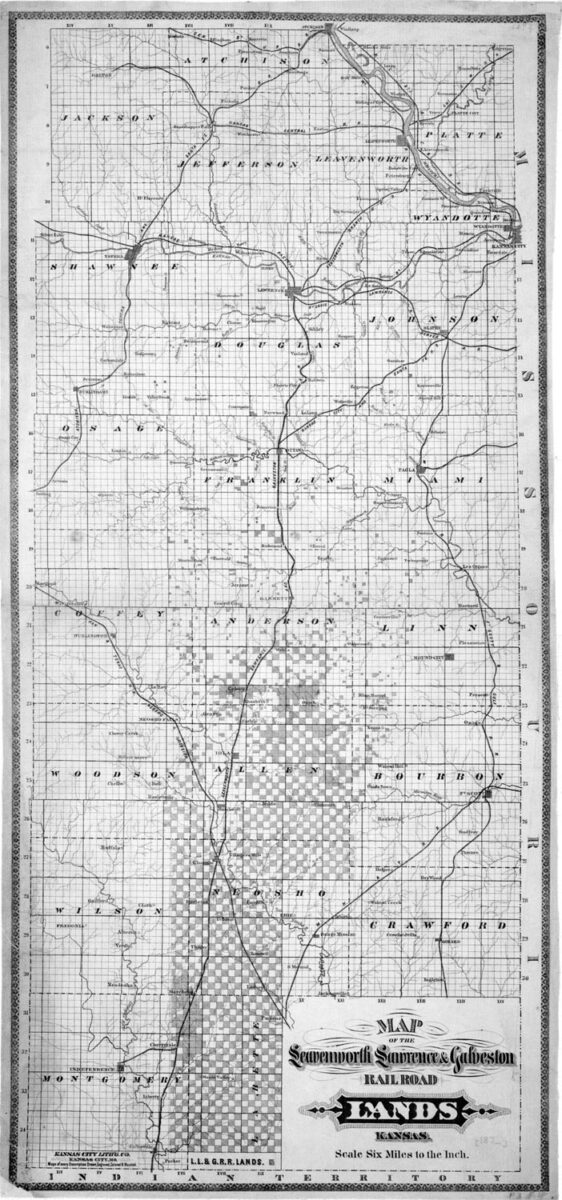
Leavenworth, Lawrence & Galveston Railroad lands, 1875.
In March 1873, the dream of through service over the new Kansas River bridge to Leavenworth, the northern terminus of the Leavenworth, Lawrence, & Galveston Railroad, was realized under the terms of its 1864 amended charter. After extended negotiations, it was announced that a contract had been signed between the Kansas Pacific and Galveston road to operate jointly through trains from Lawrence to Leavenworth, and the first train passed through Lawrence over the branch to Leavenworth the same month.
Joy’s railroads were only loosely associated, and in 1871, Jay Gould snatched the valuable Hannibal and St. Joseph Railroad, isolating the Kansas properties from the rest of the Joy system. Continued trouble over the Indian lands and the financial panic of 1873 aided his fall. Irregular dealings on a construction project precipitated Joy’s ousting from the Chicago, Burlington, and Quincy Railroad, along with several lesser figures, and the others still controlled the Kansas lines. However, vengeful fellow exiles immediately removed Joy from these companies. Receivership began on March 10, 1875, and both major Kansas properties were foreclosed in 1878.
Under the reorganization, the Leavenworth, Lawrence, & Galveston Railroad became the Lawrence and Galveston Railroad on March 5, 1879. The companies operated by the Leavenworth, Lawrence & Galveston Railroad, the Southern Kansas, and the Kansas City and Santa Fe consolidated on March 29 with the Lawrence & Galveston. The result was called the Kansas City, Lawrence, and Southern Railroad. The troublesome Indian lands and government land grants were voluntarily surrendered to the state. Congress had never ratified the Osage treaties. The two parallel railroads from the Kansas River to the Indian Territory border, although under the same management, remained separate companies and developed in different directions. The Kansas City, Fort Scott, and Gulf Railroad, a descendant of the Missouri River, Fort Scott, and Gulf Railroad, turned eastward, probing into Missouri and Arkansas. The Kansas City, Lawrence, and Southern faced westward.
Compiled and edited by Kathy Alexander/Legends of Kansas, May 2024.
Also See:
A Century of Railroad Building
Railroads & Depot Photo Gallery
Sources:

